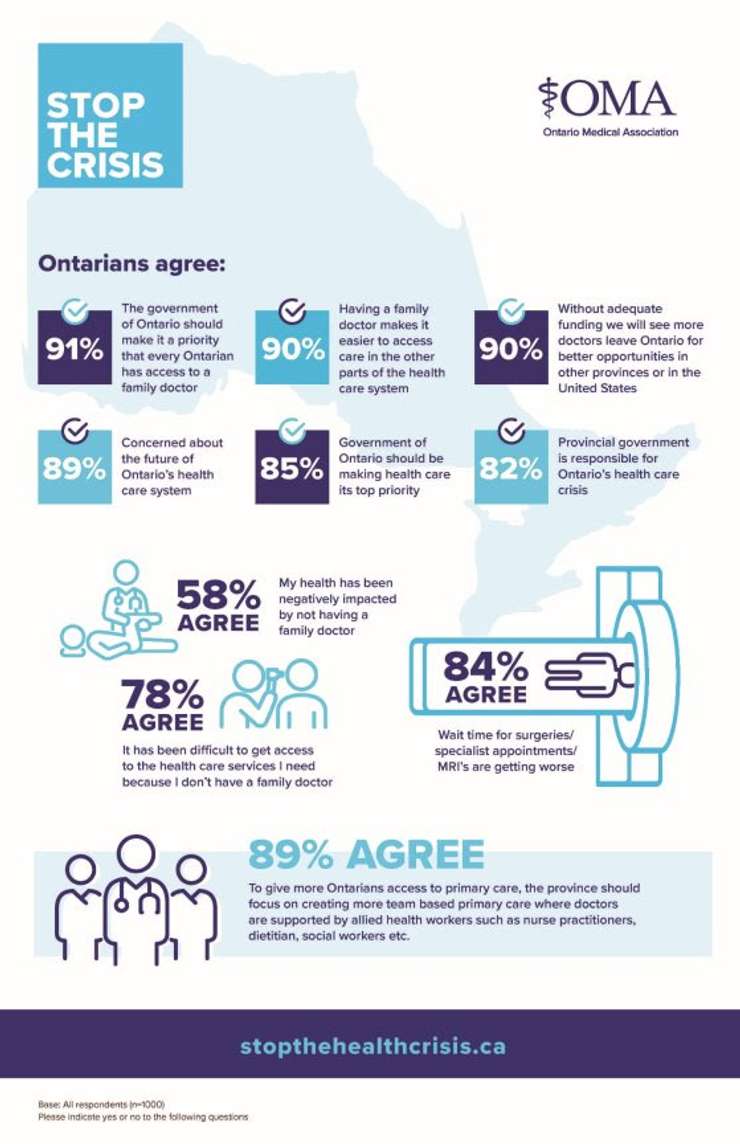The Ontario Medical Association hosted an online forum to launch its new Stop the Crisis initiative on October 16.
The goal is to direct government attention and investment towards six key priority areas.
A panel of doctors across the health system participated in the online forum. Dr. Audrey Karlinsky, a family doctor, says one of the six key points is that every Ontarian needs a family doctor. She says with over 2.5 million people not having a family doctor in Ontario, the level of care being provided isn't sufficient.
"It's heartbreaking, day after day, getting phone calls from potential patients, begging most of the time, to be added to our patient rosters, and it can't be done. There is just no capacity in the system," Dr. Karlinsky stated bluntly.
By 2026, the OMA estimates the amount of people without a family doctor in Ontario will double to nearly 25 percent of Ontarians.
Dr. Karlinsky adds that another difficulty facing many family practices is that losing staff at those practices to hospitals and bigger healthcare agencies is tough, because she can't offer competitive wages and pensions or benefits like those other settings.
"It's exhausting and it's exhausting to have 24/7 need of reviewing information that's coming all of the time at us (doctors), through our EMR, our Electronic Medical Records, to manage patient care. We train, we hire, and we lose staff all of the time. It's exhausting," Dr. Karlinsky reiterated.
Past president of the OMA and an emergency room doctor in the province, Dr. Andrew Park, says because of a lack of family doctors, more and more complex patients are coming to emergency departments where the resources haven't changed, but the demand on them is higher.
"Those without a family doctor do worse. They're sicker, their diseases present later and they place an inordinate amount of pressure on our already pressurized system, so that's what we're observing right now," shared Dr. Park. "So those are the patients that can't access a family doctor and they're coming to us. The issue is they're saying 'I can't get a family doctor to take care of these things that I know I don't want to be here for.' So they're willing to wait 3, 4, 5, 6, 7 or even more hours just to see a doctor to do something that they know they don't need to be in an emergency department for."
Dr. Park says the over 2.5 million Ontarians currently without a family doctor are now turning to emergency departments for serious disease diagnoses, like cancer, as well as more minor needs, further straining the EDs across Ontario.
Another key issue is keeping those emergency departments staffed and therefore open. Dr. Dominik Nowak, the current OMA president who moderated the OMA forum, says the government has to do more to ensure consistent staffing.
"The province needs to keep those who are practicing now until retirement, and they also need to attract new doctors to every area of Ontario to meet the needs of our communities," Dr. Nowak said. "Funding needs to keep pace with the economic realities of practice, and the province has to make sure funding is there, so that Ontario is a place where physicians want to practice and where we want to spend our careers caring for patients."
On that note, Dr. Park adds that the province needs to do a better job of maintaining rural and remote healthcare systems and gauging where the needs are most acute.
"What's really important is that we understand A: What the actual workload is for these communities and how do we best support them? And then B: How do we predict when they're gonna need more human resource support, and how do we do that in the most effective ways?" Dr. Park pointed out.
Dr. Nowak adds that part of solving some of these issues involves fast tracking more international doctors into family practice here, and also investing in digital health solutions.
"We need more efficient routes for those who have been educated in medical schools around the world to start a practice here in Ontario. We also have to embrace digital health and innovation. Embracing technology will let us, as doctors, focus on patient care," Dr. Nowak emphasized. "
The six key points the OMA is urging the government to address are:
-Every Ontarian needs a family doctor
-Save rural and northern health care in Ontario
-Keep emergency departments open
-Improve access and funding for surgeries, specialists and diagnostic tests
-Human Health Resources Strategy
-Enhance Digital Health Care and Innovation
“Our members are concerned that, without significant government intervention, health care in this province will deteriorate beyond repair,” said OMA CEO Kimberly Moran. “The OMA intends to work with government on these solutions. Ensuring the future of health care in Ontario must be a top priority.”
According to a recent survey, conducted by Ipsos on behalf of the OMA, 89% of Ontarians are concerned about the future of Ontario’s health-care system. Patients also indicated access to a family doctor and health-care priorities would influence which party they might vote for.
For more information about the crisis, descriptions of the solutions, data and analysis, patient stories and physician testimonials visit, https://www.oma.org/advocacy/stop-the-crisis/.







